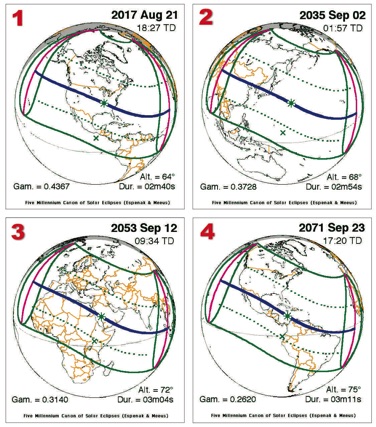Solar eclipses are produced as a result of a particular alignment of the Earth, the Moon, and the Sun. The alignment responsible for the August 21, 2017 eclipse can be seen in the main panel to the right. The same relative geometry that will result in the August 21, 2017 eclipse will not occur again until 223 synodic months have passed. A synodic month is the time taken for the Moon to complete one complete cycle of its phases (i.e. the time taken to go from a new Moon back again to a new Moon). This time period between successive eclipses, 223 synodic months, is known as the Saros cycle. A time period of 223 synodic months is also equal to 6,585.3 days or 18 years, 11 days and 8 hours. This means that the next geometric alignment similar to August 21, 2017 will not occur again until Sept. 2, 2035.
- Click here and press the Run Time Forward button to see Moon’s shadow move across the Earth’s surface for the 2035 solar eclipse.
Note that the 2035 solar eclipse is not centered over North America, but is instead centered over the Pacific Ocean. The reason for this is that the Saros period is not equal to a whole number of days, but instead has an extra time displacement of 8 hours or 1/3 of a day. This means that the Earth will have completed an extra 1/3 of a rotation (i.e. 1200) before the eclipse occurs. A total of 3 Saros periods (i.e. 3 x 1/3 = 1) are, therefore, required before a solar eclipse will return to the same geographic region. The next solar eclipse to take place in the same geographic region as the Aug. 21, 2017 solar eclipse will, therefore, occur on Sept. 23, 2071.
- Click here and press the Run Time Forward button to see Moon’s shadow move across the Earth’s surface for the 2071 solar eclipse.
Note that the Sept. 23, 2071 solar eclipse will have shifted south in location from the similar Aug. 21, 2017 solar eclipse. The reason for this is that the length of the Saros cycle is 18 years and 11 1/3 days; the extra 11 1/3 days in the Saros cycle means that each succeeding eclipse will now occur later in the year than previous eclipses. The shifting locations of the Earth and the Moon in their orbits in this extra time interval accounts for the change in the exact eclipse path location.
